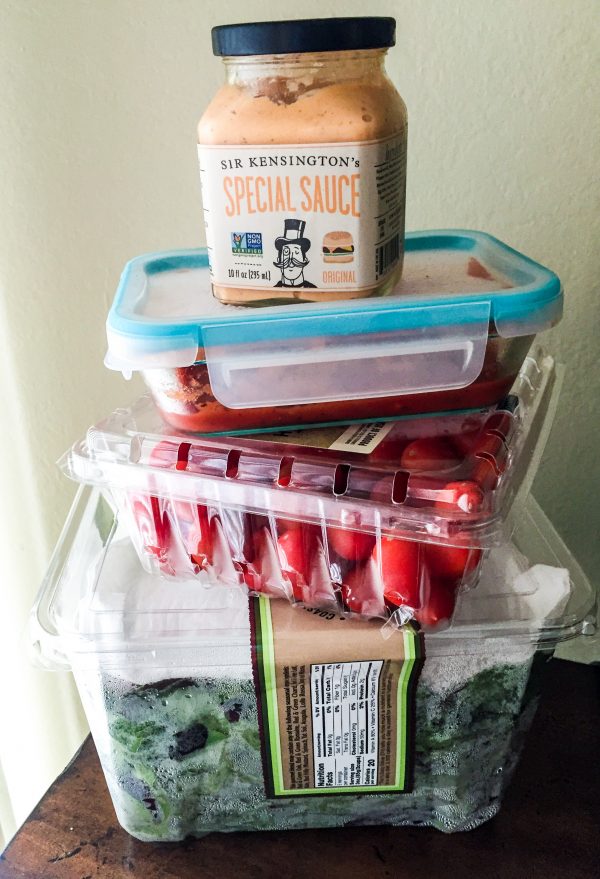I’m pretty confident that I belong in another generation. I like old music, traditional values, and my design sense leans more towards early 20th century art deco than millennial minimalism. And when it comes to food storage and saving? Well, I’m just your average depression-era grandmother. Haste makes waste, you know.
In all seriousness, I don’t like the idea of wasting food. Most of us live with so much food when a huge proportion of the world lives with so little, so it makes me crazy when I think about all the food that’s getting thrown out. Guess what, there actually are starving kids all over the world (and in our own backyard) that would love to have your leftover chicken and rice or cauliflower pizza.
Phew. On a lighter note, you don’t need to start wringing your hands and going through your trash in utter devastation over the chicken bone you just threw out. Because there’s obviously a time and a place for throwing out old food or junk you don’t need. But for the healthy, delicious food that you should be saving and using up, there’s a light at the end of the tunnel. And I’m here to help with some practical, doable, real-life hacks to best save and utilize your food.
Editing Your Kitchen: 10 Food-Saving Hacks
- Organize, organize, organize
I’ve said it before, and I’ll say it again. Having a well-organized fridge and pantry is key to eating healthy. And it also helps you avoid wasting ingredients. If you know exactly where everything is, you’re more likely to use what you already have and less likely to overbuy at the grocery store or forget about an item. - Cook your greens and veggies
This is one of the best ways you can save those precious, perishable veggies. Cook them. I’ll often get halfway through a Costco-size box of spinach and realize I’m not going to be able to use it before it goes bad. So, I get out a pan and cook the rest up with some lemon and butter or ghee. Bonus: Cooked veggies can also be easier on the digestive system. Win-win! - Buy multipurpose condiments
Don’t buy a ton of specialty condiments, sauces, or dressings if you only intend to use them once or twice. Buy items that you enjoy on different kinds of food and can see yourself using a lot before they go bad. For example, I love dijon mustard. I’ll use it in homemade salad dressings, as a quick chicken marinade, or spread on pieces of deli meat. I know I’m going to use it a ton of times, so I buy it. Simple, right? - Embrace the end-of-week salad (or omelette)
One of the best ways to utilize all your extra produce at the end of the week is to make a big salad for dinner, or throw it into a frittata or omelette. I’ve eaten some surprisingly delicious dishes through this method, and it has even helped inspire some of my favorite recipes (Supreme Pizza Salad, for starters). - Clean out your fridge before you shop
Remember that huge container of yogurt you just bought because you weren’t sure if you needed it? Well, there was another one hidden in the back of your fridge. Just knowing what’s in your fridge before you shop can help cut out food waste. So the next time you’re thinking of heading over to Sprouts or Costco, take a quick fridge inventory and see what you already have. - Place your perishables front and center
Kind of like my tip for organizing your pantry, always place the ingredients you want to use immediately in your direct path. If that means moving some of your produce out of the drawers and onto the shelves, so be it. I’m a visual person, so having those perishables front and center means I’m more likely to use them. - Freeze desserts and baked goods
Here’s the thing. I love desserts and baked goods, but I don’t like feeling obligated to eat all of them within a week. If I have friends or family over, it’s fine. But making 2 dozen gluten-free doughnuts for myself is not a good idea. Freezing desserts and baked goods is my consolation prize for baking. Not only do baked goods freeze well, but some actually taste pretty good right out of the freezer. Seriously, have you ever tried a frozen brownie? - Portion out what you need to use ASAP
Use small tupperware containers to make manageable portions of food you need to use. If you’re like me, seeing one giant bowl of sliced cucumbers isn’t always inspiring. You still have to figure out what you’re going to use it in. Instead, put those sliced cucumbers in small containers with some grape tomatoes, carrot sticks, and hummus, and you’ve got yourself a little snack pack. - Prep as much as you can
Cut chicken into easy-to-eat pieces, chop veggies, and wash and dry some of your produce. If you’re in a hurry, you’re not going to grab a whole head of cabbage and a rotisserie chicken. But, some sliced apples and chicken strips? Yeah, I can get behind that. - Store food properly
Most prepped produce should be stored with paper towels to absorb the moisture. You’re going to get a lot more life out of your produce if you fight that moisture and condensation when you can. I always do this with lettuce as well as most other water-rich produce like cucumbers and zucchini.
There you have it, 10 food-saving tips to help you use what you have and avoid throwing out perfectly good food. Try a few out, and let me know if you have any food-saving hacks of your own to add to the list!
